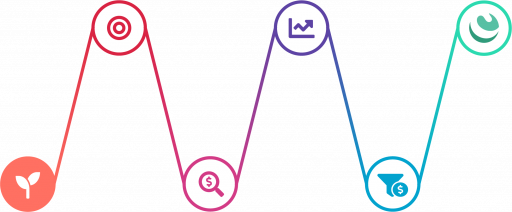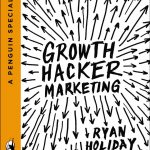Series Growth Hacker? Marketing your app is not an extra task 1/6
Launch and then market does not work, marketing must be embedded in your app
In the last five years, we have heard many many times the question: “What would it take to create my mobile/web app?”. In our series of articles about going from an idea to an app, we explained in detail all the major steps of the adventure and we gave an idea of the efforts required. It is difficult to translate these efforts to a budget (money and/or time). However, after having invested money and time, your app is ready, but the question remains: “Where are my users?”.

Yes, the app is out there, but why they do not flock to you? At that point, the energy and the money are quite low and you find yourself wondering if all the efforts were really worth it. In the articles of the series from an idea to an app, we introduced the importance of marketing. We also gave you an estimate of the total budget you should dedicate to it (around 30% of the total budget of your project). With this new wave of articles, we want to explain that the marketing budget should not be an extra expense. It is important to embed the majority of the marketing efforts already in the conception, design and development of your app or service. This series introduces you to the world of growth hacking marketing and explain how we integrated its concepts and best practices in the services we offer to you. For this, we got a little help from a pioneer of growth hacking: Ryan Holiday.
To write this series of articles we got inspired by the excellent work of Ryan Holiday in his book: “Growth Hacker Marketing”. Throughout the articles we use some of his definitions and examples that are relevant to our field of interest. The goal is to show and demonstrate how the concepts of Ryan Holiday naturally fit in our approach for mobile apps and services conception and development. Let’s start with a conversation between two marketing techniques that we will call “the old way” and “the new way”.
The talk show
Let’s begin our talk show, I’m MobileThinking and we are here this evening with two marketing techniques:
MobileThinking: “Welcome to ‘The old way’ and ‘The new way’!”
‘The old way’: “Good evening, thank you for having invited us here tonight!”
‘The new way’: “Hi, I hope you already invited all your friends to follow the debate!”
MobileThinking: “Let’s start with a simple question, at which moment do you enter the marketing game?”
‘The old way’: “Normally, at the end when everything is ready, we promote what we have.”
‘The new way’: “Naturally from the very beginning, even before to start the product design, to better understand our future prospects and how to design the product for them.”
MobileThinking: “Who are your prospects and how you communicate with them?”
‘The old way’: “Anyone, we push the product as hard as we can. We try different communication approaches to reach as many customers as we can. We usually bombard people with the product to exhaustion!”
‘The new way’: “We know exactly who are our prospects, what they need, where we can find them, and how we can best help them solve their problem with our product. They come to us ‘naturally’.”
MobileThinking: “How do you prepare the launch day?”
‘The old way’: “The launch day is the big deal! There is no room for failure, if we fail the product is done and a lot of money is lost. We basically brace for impact, very exciting!”
‘The new way’: “There is no launch day… well there is some sort of ‘launch day’ when we first expose our idea with selected prospects, but then the product simply exists, evolves, gets advertised, and scales with the help of its own users.”
MobileThinking: “Which is one of your most famous techniques?”
‘The old way’: “We like red carpet events and very expensive advertising campaigns.”
‘The new way’: “One very cool technique is to ‘piggyback’ our value proposition into other outstanding services and use their growth to grow our user base.”
MobileThinking: “What are your budget requirements?”
‘The old way’: “Put aside 50% of the total budget at disposal to be sure to reach as many people as possible and convince them to buy the product.”
‘The new way’: “Apart some specific click advertising campaign or specific collaborations, our budget is embedded in the ‘making of’ of the product. I guess we can clarify this, later...”
MobileThinking: “Finally to conclude today episode, can you give an example of the industry your are currently working in?”
‘The old way’: “We are still active in the movie industry, in the car industry and other retailers.”
‘The new way’: “Our favorite playground are tech startups proposing new services and innovative companies willing to launch their next success product.”
MobileThinking: “Let’s thank ‘The old way’ and ‘The new way’ for their words of wisdom, we will meet them again soon to discuss more in depth some of the major points of today conversation.”
MobileThinking: “Welcome to ‘The old way’ and ‘The new way’!”
‘The old way’: “Good evening, thank you for having invited us here tonight!”
‘The new way’: “Hi, I hope you already invited all your friends to follow the debate!”
MobileThinking: “Let’s start with a simple question, at which moment do you enter the marketing game?”
‘The old way’: “Normally, at the end when everything is ready, we promote what we have.”
‘The new way’: “Naturally from the very beginning, even before to start the product design, to better understand our future prospects and how to design the product for them.”
MobileThinking: “Who are your prospects and how you communicate with them?”
‘The old way’: “Anyone, we push the product as hard as we can. We try different communication approaches to reach as many customers as we can. We usually bombard people with the product to exhaustion!”
‘The new way’: “We know exactly who are our prospects, what they need, where we can find them, and how we can best help them solve their problem with our product. They come to us ‘naturally’.”
MobileThinking: “How do you prepare the launch day?”
‘The old way’: “The launch day is the big deal! There is no room for failure, if we fail the product is done and a lot of money is lost. We basically brace for impact, very exciting!”
‘The new way’: “There is no launch day… well there is some sort of ‘launch day’ when we first expose our idea with selected prospects, but then the product simply exists, evolves, gets advertised, and scales with the help of its own users.”
MobileThinking: “Which is one of your most famous techniques?”
‘The old way’: “We like red carpet events and very expensive advertising campaigns.”
‘The new way’: “One very cool technique is to ‘piggyback’ our value proposition into other outstanding services and use their growth to grow our user base.”
MobileThinking: “What are your budget requirements?”
‘The old way’: “Put aside 50% of the total budget at disposal to be sure to reach as many people as possible and convince them to buy the product.”
‘The new way’: “Apart some specific click advertising campaign or specific collaborations, our budget is embedded in the ‘making of’ of the product. I guess we can clarify this, later...”
MobileThinking: “Finally to conclude today episode, can you give an example of the industry your are currently working in?”
‘The old way’: “We are still active in the movie industry, in the car industry and other retailers.”
‘The new way’: “Our favorite playground are tech startups proposing new services and innovative companies willing to launch their next success product.”
MobileThinking: “Let’s thank ‘The old way’ and ‘The new way’ for their words of wisdom, we will meet them again soon to discuss more in depth some of the major points of today conversation.”
With the above conversation we presented some general concepts that apply to both techniques. Growth hacking is a full new field in the marketing world and it requires the interaction of different expertises. At MobileThinking we can guide you to integrate growth hacking marketing in your project. We know how to analyse your business, to iterate your product, to advise you on the best end user practices, and to interact with professionals in the sector of growth hacking marketing. We can help you understand who your end users are, what their needs are, where they are, to design a product that will catch their attention and solve their problem optimally. All of these steps are not just development and design decisions, but marketing choices. We naturally integrated several of the growth hacking techniques in our workshops and design sprints. Additionally, we adapted our development cycle to facilitate the integration of growth hacking techniques directly in the core architecture of the apps we develop.
In the following articles, we will explore some of them more in depth with tangible example from our experience and some borrowed from Ryan Holiday’s book.
In the following articles, we will explore some of them more in depth with tangible example from our experience and some borrowed from Ryan Holiday’s book.
Stay tuned
The next articles in this series are:
- Product market fit
- Finding your growth hack
- Going viral
- Close the loop: retention and optimization
- Conclusions
You can subscribe to our LinkedIn account to be informed when we release the next articles of this series as well as other MobileThinking news.



